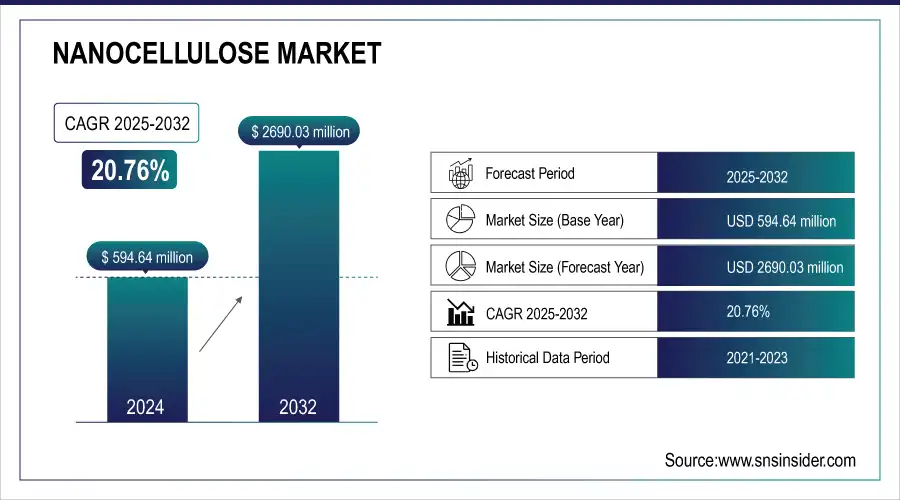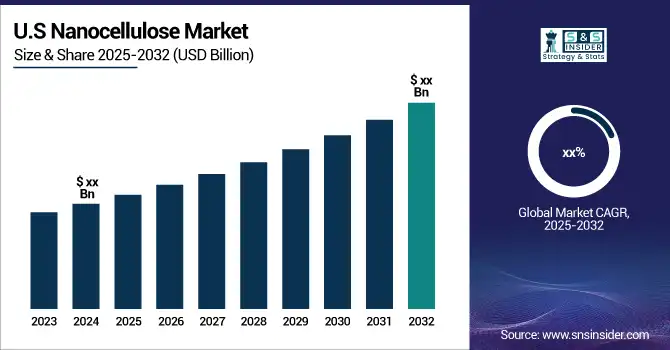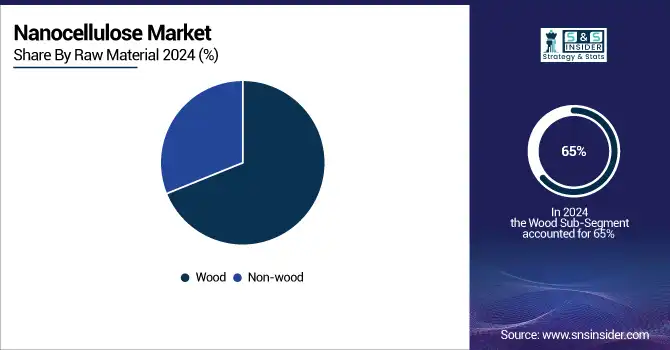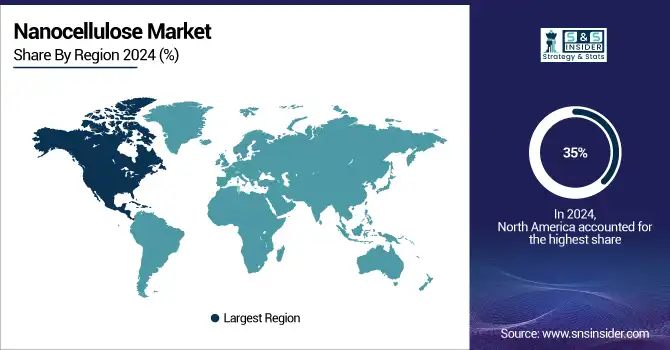Nanocellulose Market Report Scope & Overview:
The Nanocellulose Market Size was valued at USD 594.64 million in 2025E and is expected to reach USD 2690.03 Million by 2033 and grow at a CAGR of 20.76% over the forecast period 2026-2033.
The nanocellulose market has witnessed rapid growth in recent years due to the urgent demand for eco-friendly products in various industries. Derived from plant cellulose, nanocellulose possesses extraordinary properties including a high strength-to-weight ratio, biodegradability, and surface area, thus opening up versatile applications in packaging, construction, textiles, and healthcare. The high demand for sustainability and the shift to green technologies are what mainly drive the market trends. As companies seek to replace petroleum-based products, nanocellulose becomes a critical piece of developing biocompatible and recyclable materials healing the environment and responding to regulatory pressures.
Market Size and Forecast:
-
Nanocellulose Market Size in 2025E: USD 594.64 Million
-
Nanocellulose Market Size by 2033: USD 2690.03 Million
-
CAGR: 20.76% from 2026 to 2033
-
Base Year: 2025
-
Forecast Period: 2026–2033
-
Historical Data: 2022–2024

Get more information on Nanocellulose arket - Request Sample Report
The U.S. Nanocellulose market size was valued at an estimated USD 230.00 million in 2025 and is projected to reach USD 1,040.00 million by 2033, growing at a CAGR of 20.1% over the forecast period 2026–2033. Market growth is driven by increasing applications of nanocellulose in composites, packaging, biomedical, electronics, and coatings due to its biodegradability, high strength, and lightweight properties. Rising demand for sustainable and eco-friendly materials, along with growing adoption in advanced material engineering and medical devices, is accelerating market expansion. Additionally, technological advancements in production processes, supportive government initiatives for sustainable materials, and growing R&D investments further strengthen the robust growth outlook. Recent breakthroughs point out the growing interest in nanocellulose application developments. In October 2024, it was shown that research can be capable enough to enhance the mechanical properties of composite materials leading toward high-performance applications.

Key Nanocellulose Market Trends
-
Growing use in the paper and packaging industry to enhance strength, barrier properties, and reduce material consumption.
-
Increasing applications in biomedical and healthcare sectors, including wound dressings, drug delivery, and tissue engineering.
-
Expansion of nanocellulose use in coatings, adhesives, and composites for automotive, construction, and electronics industries.
-
Advancements in production technologies reducing cost and improving scalability of nanocellulose materials.
-
Rising interest in nanocellulose-based films for flexible electronics and renewable energy applications.
-
Growing regulatory support and environmental awareness boosting demand for eco-friendly, renewable nanocellulose products.
-
Research and development initiatives focusing on functionalization and performance enhancement for specialty applications.
Nanocellulose Market Growth Drivers
-
Increasing Emphasis on Sustainability and Eco-Friendly Products Is Driving the Demand for Nanocellulose
The increased demand for sustainability and eco-friendly products has accelerated the demand for nanocellulose, an ultimate form of cellulose from renewable sources. This biodegradable, all-natural polymer is a green alternative to synthetic materials in a multiplicity of applications, such as packaging and construction. Attention has been brought to nanocellulose partly due to the efforts being made by various industries towards the reduction of their footprint on the environment. With the ongoing global concerns regarding plastic pollution and depleting fossil resources, businesses are in a quest to find sustainable replacements that achieve comparable performance. Nanocellulose boasts superior mechanical properties low weight and versatility, making it perfectly suitable for areas where the traditional material fails. Besides this, the requisite regulatory framework in most parts of the world is nudging for the use of green materials, thereby expanding the market. Since awareness about consumers is growing, companies are now introducing more nanocellulose to their product lines to benefit from the environmentally conscious consumer. This in turn aids not only in building brand reputation but also in the attainment of sustainability objectives. For instance, in packaging, nanocellulose-based films and coatings are now an effective alternative for the reduction of plastic without sacrificing barrier properties. Overall, the steadily growing demand for environmentally friendly materials gives huge impulse to the nanocellulose market and positions it at the core of the shift toward a greener economy.
-
Rapid advancements in nanotechnology are propelling the nanocellulose market
New developments in nanotechnology accelerate the nanocellulose market and open opportunities for new, innovative applications as well as the development of new products with higher performance. It has now been possible to exercise new degrees of control over materials at the nanoscale and thereby open new fields of application for nanocellulose utilization. New developments in nanotechnology have improved the isolation and processing techniques of nanocellulose, enhancing purity and functionality. Techniques such as acid hydrolysis, enzymatic treatment, and mechanical processing have made it possible to extract nanocellulose fibers from diverse cellulose sources wood, agricultural residues, and even waste paper. This has made it possible for manufacturers to manufacture nanocellulose with tailored properties, strength improved thermal stability, and optical clarity, wherein it has numerous applications in high-performance applications. Recently, nanocellulose-based composite materials have attracted much attention due to their better mechanical and barrier properties than traditional materials. Electronics, biomedical industries, and automotive have shown great potential for the use of nanocellulose through drug delivery systems, lightweight materials, and biodegradable packaging. Thus, perpetually refreshed research activity and academia-industry collaboration would further substantiate nanotechnology development and allow for a wider range of applications of nanocellulose. Innovations, again driven by nanotechnology, have served as only a catalyst in assisting nanocellulose toward the environmentally friendly construction of advanced materials.
Nanocellulose Market Restraints
-
Limited Production Capacity and High Costs
The production of nanocellulose is highly limited because of minimal industrial-scale manufacturing capabilities and relatively high costs associated with extraction and processing. These can limit the scope of the market and usage. Nanocellulose promises many interesting properties and applications, yet it remains not commercially viable owing to the complications involved in the production process. The extraction processes are often highly capital-intensive and depend on certain equipment and professional skills, which can be out of reach for many potential manufacturers. Another major aspect that is still in the development stage is the capability for large-scale production; small-scale laboratories can be effective at making nanocellulose, but large-scale production has proved difficult to scale up, often causing shortages and higher prices, which has made the adoption of nanocellulose integration in their products a challenging task for business firms. Raw materials inputs include expensive wood or agricultural residues; the processing technology involved in getting nanocellulose is not straightforward. Under such circumstances, the potential clients may not find the spending worthwhile on nanocellulose solutions and would opt for the more established materials which also present cost advantages. Until breakthroughs take place within the production techniques and the associated costs are therefore reduced, this remains the most critical constraining influence upon the growth curve of the nanocellulose market.
Nanocellulose Market Opportunities
-
Expanding Applications in Various Industries
The flexibility of nanocellulose can indeed open huge avenues in various sectors like packaging, pharmaceuticals, textiles, and electronics. New applications keep emerging with advancements in research, which drives the market growth. The characteristics that distinguish nanocellulose are lightweight, a high surface area, and great mechanical strength, suitable for diverse applications. For instance, nanocellulose enhances barrier properties in the industry of packaging. As such, this offers a very practical solution regarding biodegradable packaging materials, considering the rising sensibility of consumers towards sustainability. From a drug delivery system perspective, nanocellulose is also under study in the pharmaceutical sector. Biocompatibility and encapsulation capabilities enhance the therapeutic efficacy of drugs. In textiles, it can be used to create light, durable, and moisture-wicking fabrics. Besides this, nanocellulose composites develop toward the electronics application field, including its use in flexible displays, sensors, and energy storage. Newly emerging research and development will most probably accelerate the creation of new products and applications, creating market demand. Lately, due to worries over sustainability, alternative sources to synthetic materials are becoming popular, which makes usage increase significantly with nanocellulose. The nanocellulose market can utilize emerging opportunities in diverse sectors through multifunctional properties and other challenges related to sustainability.
Nanocellulose Market Challenge:
-
Navigating the complex regulatory landscape can hamper market entry and slow down innovation.
The regulatory hurdles and other safety aspects of nanomaterial utilization in the nanocellulose market will remain challenging. The exact regulatory framework governing the utilization of nanomaterials is a barrier to new entries in a market and slows innovation. With the wide application of nanomaterials, regulations by regulatory authorities across the world are being established to ensure safety and the environment. The regulatory framework for nanomaterials remains in the development stage. Thus, it lacks clarity and consistency with standards. The time needed to seek approvals for products prepared using several techniques might lead to delays at the time of entry into the markets. Exposure risks related to nanocellulose, which are considered to be relatively low, remain under investigation. This sector, however, continues to hold open the question of long-term human and environmental health impacts from nanocellulose exposure. This would mean still higher scrutiny from regulatory boards and even stricter regulations in the near future. Such uncertainty may make even more manufacturers and investors hesitant to enter the market. In addition, the price and time spent on regulatory compliance burden smaller companies, thereby reducing their competitiveness relative to the bigger players. Thus, regulation barriers and issues of safety will be relevant to the development of the nanocellulose market to become well-established in many end-user applications.
Nanocellulose Market Segment Analysis
By Raw Material
In 2025, the wood segment dominated the global nanocellulose market, accounting for an estimated 65% of the market share. Wood is the raw material most abundantly used for the production of nanocellulose, given that it is readily available and also contains the largest proportion of cellulose. Techniques for obtaining wood-derived nanocellulose are well developed, such as mechanical refining and chemical treatment, making the material highly favored by manufacturers due to its relatively low cost. Such nanocellulose based on wood also exhibited superior mechanical and barrier properties, extremely interesting for applications in packaging, composites, and coatings. Actually, for example, nanocomposite films of biodegradable polymers can be largely reinforced with the integration of wood-derived nanocelluloses and serve as a sustainable alternative to plastic. Given the rising demand for green materials, the wood segment will probably remain the largest due to the technological advancements of extraction technologies and the growing concern for sustainability within several business lines.

By Type
Cellulose Nanofibrils dominated the nanocellulose market in 2025, with an estimated share of 45%. Cellulose Nanofibrils are gaining popularity because of their exceptional mechanical properties, high surface area, and potential in numerous applications. CNF is quite popular among composites that help increase strength and durability to embrace the demands such as packaging and construction industries. Examples: In the case of barriers against moisture and gases for biodegradable packaging films, CNF is added more for enhancement of this while keeping the shelf life intact and also sustaining. Furthermore, the potential of the CNF to reinforce materials such as bio-composites and textiles, also extends into other fields. In the quest for innovation and environmental protection, Cellulose Nanofibrils are the kind of product that can be expected to witness growing demand from companies to make this segment a market leader for nanocellulose.
By Application
In 2025, the Pulp & Paperboard segment dominated and accounted for about 40% of the nanocellulose market. The largest consumer of nanocellulose is Pulp & Paperboard, as this particular material uses a number of the unique properties of nanocellulose to enhance quality and performance in paper-based products. Nanocellulose can strengthen the strength, rigidity, and barrier characteristics of paper and paperboard, making paper and paperboard stronger and more useful. Nanocellulose allows paper and paper products to be made thinner with less weight. Such sheets will withstand tensile strength without sacrificing performance. It is also here that nanocellulose finds specific utility in the packaging industry: consumers prefer light materials for packing. In addition, nanocellulose may improve printability and optical properties of paper, which are critical for printing applications requiring high quality. Its eco-friendly paper production capacity makes nanocellulose further appreciated to dominate the market in high preference, motivating manufacturers to use this innovative material for both traditional and specialty paper applications.
Nanocellulose Market Regional Analysis
North America Nanocellulose Market Insights
The North American region dominated the nanocellulose market in 2025, with a market share of around 35%. The North American region has been in the frontline position due to substantial investments in research and development and through sustainability and innovation in the different sectors. The region is also dominated by several leading players and scientific research institutions that are actively researching the applications of nanocellulose. Nanocellulose, combined with biodegradable packaging solutions, is being adopted by companies in the United States to meet the growing consumer demand for eco-friendly products. Within the realm of biomedical industries, nanocellulose is being exploited as a material for drug delivery systems and wound dressings due to its biocompatibility and contribution to healing properties. North America is continuing to hold an established market position with well-established forestry resources and manufacturing capabilities. As sustainability initiatives become more widespread, the region will probably continue its lead in the growth of nanocellulose innovation and application, paving the way for enhanced growth and adoption into different industries.

Get Customized Report as per your Business Requirement - Request For Customized Report
Asia Pacific Nanocellulose Market Insights
Asia-Pacific region emerged as the fastest growing region with a CAGR value of 12%. This region is growing at a rocketing pace due to the demand for sustainable materials and increased industrialization and development of nanotechnology. Although Asia-Pacific is growing rapidly with these three factors; however, the market will take a considerable lead by China, followed by Japan and India, which are heavily investing in the development and commercialization of nanocellulose for respective use in various industries such as packaging, textile, and construction sectors. For example, a rapidly growing packaging industry in China uses nanocellulose to produce light, biodegradable products that are alternatives to plastics, which pollute the environment. The textile industry of India is also using nanocellulose for developing novel, functional textiles with superior properties involving moisture and antimicrobial functions. Moreover, green technologies, along with the inducement of sustainability at the governmental level, have created an encouraging scenario for the growth of nanocellulose applications in the region. As a result of the increasing intentions of several industries to employ eco-friendly solutions, the nanocellulose market is likely to exhibit massive growth in the Asia-Pacific region in the coming years.
Europe Nanocellulose Market Insights
The Europe nanocellulose market is witnessing robust growth in 2025, driven by increasing demand for sustainable, biodegradable materials in packaging, paper, and composites. Key markets such as Germany, France, and the U.K. are investing in research and commercialization of nanocellulose-based coatings, films, and composites for industrial and biomedical applications. Stringent environmental regulations, a strong focus on circular economy initiatives, and adoption of renewable materials in automotive, electronics, and healthcare sectors are further propelling market growth.
Latin America (LATAM) Nanocellulose Market Insights
The Latin America nanocellulose market is expanding steadily in 2025, fueled by growing interest in eco-friendly packaging and sustainable materials. Brazil, Mexico, and Argentina are key markets where packaging, paper, and construction industries are exploring nanocellulose applications to improve product strength, reduce material usage, and enhance barrier properties. Increased government initiatives supporting green technologies and rising consumer awareness of sustainable products are further driving adoption across the region.
Middle East & Africa (MEA) Nanocellulose Market Insights
The MEA nanocellulose market is gaining traction in 2025, supported by rising demand for high-performance materials in packaging, healthcare, and coatings. Countries such as the UAE, Saudi Arabia, and South Africa are witnessing early adoption of nanocellulose in specialty applications, including biomedical products, cosmetics, and renewable energy solutions. Investments in sustainable industrial practices, coupled with growing regulatory focus on environmentally friendly materials, are accelerating market penetration in the region.
Nanocellulose Market Competitive Landscape
VTT
VTT is a leading Finnish research and technology organization specializing in applied science and innovative materials.
-
In August 2024, VTT launched a bioactive skin spray using nanocellulose and antimicrobial compounds from wild berries for wound treatment and MRSA prevention. The product, which can also act as a cream or dressing, aims to replace synthetic preservatives in cosmetics. VTT is seeking partners for its market launch, emphasizing the healthcare potential of berry extracts.
Nanocellulose Market Key Players
-
American Process Inc. (BioNanocellulose, Nanostretch)
-
Borregaard (LignoBoost, LignoDisperse)
-
Celluforce (Cellulose Nanocrystals, Cellulose Nanofibrils)
-
Daicel Finchem Ltd (Daicel Nanocellulose, Cellulose Nanofibrils)
-
Kruger Inc. (Kruger Nanocellulose, Pulp & Paper Products)
-
Nippon Paper Industries Co Ltd (Nippon Paper Nanocellulose, Paper Products)
-
Rettenmaier & Sohne GmbH + Co KG (Rettenmaier Nanocellulose, JRS Specialties)
-
Sappi Ltd (Sappi Nanocellulose, Sappi Biotech)
-
Stora Enso (Stora Enso Nanocellulose, DuraSense)
-
UPM (UPM Formi, UPM BioVerno)
-
Ahlstrom-Munksjö (Ahlstrom-Munksjö Nanocellulose, Fiber-Based Products)
-
BASF SE (BASF Cellulose Nanofibers, Dispersions)
-
Canfor Corporation (Canfor Nanocellulose, Wood Fiber Products)
-
Clariant AG (Clariant Nanocellulose, Functional Additives)
-
Domtar Corporation (Domtar Nanocellulose, Specialty Pulp)
-
Georgia-Pacific LLC (Georgia-Pacific Nanocellulose, Pulp Products)
-
International Paper Company (International Paper Nanocellulose, Fiber-Based Products)
-
Kamiyama Paper Co. Ltd (Kamiyama Nanocellulose, Specialty Papers)
-
Nanocellulose, Inc. (Nanocellulose Gels, Nanofibrils)
-
The Paper and Paperboard Packaging Environmental Council (PPEC) (Sustainable Packaging Solutions, Recycled Fiber Products)
| Report Attributes | Details |
|---|---|
| Market Size in 2025E | US$ 594.64 Million |
| Market Size by 2033 | US$ 2690.03 Million |
| CAGR | CAGR of 20.76% From 2026 to 2033 |
| Base Year | 2025 |
| Forecast Period | 2026-2033 |
| Historical Data | 2022-2024 |
| Report Scope & Coverage | Market Size, Segments Analysis, Competitive Landscape, Regional Analysis, DROC & SWOT Analysis, Forecast Outlook |
| Key Segments | •By Type (Cellulose Nanofibrils (CNF), Cellulose Nanocrystals (CNC), Bacterial Nanocellulose (BNC), Others) •By Raw Material (Wood, Non-wood) •By Application (Pulp & Paperboard, Composites, Biomedical & Pharmaceuticals, Electronics Sensors, Textiles, Others) |
| Regional Analysis/Coverage | North America (US, Canada), Europe (Germany, France, UK, Italy, Spain, Poland, Russsia, Rest of Europe), Asia Pacific (China, India, Japan, South Korea, Australia,ASEAN Countries, Rest of Asia Pacific), Middle East & Africa (UAE, Saudi Arabia, Qatar, Egypt, South Africa, Rest of Middle East & Africa), Latin America (Brazil, Argentina, Mexico, Colombia Rest of Latin America) |
| Company Profiles | Nippon Paper Industries C0 Ltd, Rettenmaier & Sohne GmbH + Co KG , UPM, Daicel Finchem Ltd, Stora Enso,Celluforce, Sappi Ltd, Borregard, American Process Inc., Kruger Inc and other key players |

